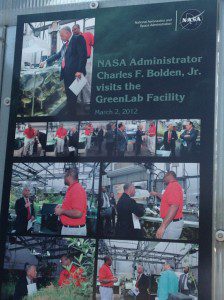During a recent visit to the NASA Glenn Research Center in Cleveland, Ohio, my colleagues and I were taken on a tour on the GreenLab research facility. Dr. Bilal M. M. Bomani demonstrated and explained how and why the lab is in existence and the purpose it serves. 
At first glance, you would not know what was behind the door of the garage-styled shed, but once the door opens, total amazement takes over. Upon entering the facility, you first notice the temperature is comparable to an actual greenhouse. It’s noisy, and there are fish tanks and plants throughout. In the back of the GreenLab, it was cooler due to the temperature being controlled by green resources. The lab was cooled using fans blowing on a grill filled with water.
Dr. Bomani explained that this lab’s intent is to find alternatives to the way we currently produce fuel. Its purpose is to create a self-sustaining, renewable energy, eco-system that can be used anywhere in the world. In other words, it could be used for food, fuel and water. The lab is also self-sustaining thanks to getting its energy through solar, wind, and hydropower.
The GreenLab’s significance towards a “green” life is to change the methods currently used to obtain energy and fuel resources. The GreenLab uses a greenhouse effect – the plants get energy to grow from the sun by means of phototropism, in a closed, temperature-controlled atmosphere. The roots grow into the sand and water to obtain nutrients by means of chemotropism. On coastlines, plant roots get their nutrients and fish like to feed. The lab’s eco-system is modeled after this type of coastline environment, because we will never run out of salt water and sandy beaches.
To make this self-sustaining, environmentally sound, closed lab, the scientist do not: 1) use fresh water; 2) compete with food crop; 3) use chemical fertilizer; and, 4) use arable land. What do they use? They use salt water, beach sand, and fish waste; the same conditions that are found on a typical coastline. The fish waste powers the plants. As an alternative to conventional fuel, the waste is also used to fuel aviation aircraft. The algae grown from the fish tanks in the lab, is taken to a facility to be processed into liquid, then converted to oil, and then manufactured into bio-fuel for aircrafts. (This is not the same process used for transportation fuel because further processing is involved.)
Most green labs use paddle wheels to agitate the water in the fish tanks, emulating waveforms that bodies of water produce. With this technique, problems emerged due to algae forming on one-side of the tanks, resulting in clogging, stacking and stagnant water. In the GreenLab, the technique used for a more natural oceanic environment is called waving. In the first tank (Test 1), waving the water with a wave generator produced a 94% mixing rate, which resulted in nice, smooth waves. Dr. Bomani’s revolutionary design for the second fish tank (Test 2) consisted of 99% mixing, resulting in a more tidal wave form. Both tanks were started at the same time; however, Test 2 had different levels of growth of algae. That is why Test 2 has a darker green color than Test 1.
The significance of waving was evidenced in the real-time data analysis. The data taken for three days showed that test 1, had an absorbency rate of 0.168, while test 2 absorbency rates were 0.632. This data shows that different wave percentages produced different amounts of growth in the algae, which has not been done prior to now. Why is this significant? The way mixing is done in industry will be revolutionized with the method discovered at NASA!
Download the NASA pdf photos here: http://wtwh-archive.s3.amazonaws.com/videos/GreenLab_PPT_April_2012final.pdf
An important growth of algae is light absorbency. Waving helps the algae get the sunlight it needs throughout the tank. Thus, sunlight helps to produce more algae, which in turn, produces more oils for production. Although algae are an expensive way of extracting fuel, Halophytes are economically cost-efficient. Halophytes are salt-tolerating plants, which can survive in salt or fresh water environments. Halophytes are used in the GreenLab for specifications needed for jetfuel (biojet); yet, are edible. Realistically, Halophytes can grow on coastal areas in arid conditions.
Ingeniously, Dr. Bomani paralleled the circle of fish life within the GreenLab facility. What did Dr. Bomani juxtapose? He compared the reasons why Sea Bass, Tilapia, Carp, and Shrimp taste so good. Since each of these fish is farm-raised, the waste from the Sea Bass goes to the Tilapia; the Tilapia waste goes to the Carp; and, the Carp waste goes to Shrimp hachery. The Shrimp waste goes back to the beginning. This method of life cycling is called sea-to-sea or cradle-to-cradle. Essentially, this method can be used for fuel.
How does the GreenLab cut costs in its research? The GreenLab uses microgrid technology. The wind turbine saves $40k/yr in energy costs and numerous dollars in CO2 emissions. The GreenLab does not use battery technology, but instead, retrieve its power from hydroenergy using 200k-gallon water tanks.
What is the future of the GreenLab? One of the most intriguing aspects of the GreenLab is that it is a STEM institute. All major topics taught in used in the facility. The GreenLab not only gets its funding from NASA, it receives funding from private companies and local municipalities to conduct the research. Companies can use the information gathered from the GreenLab and become “green” entities. Therefore, the GreenLab is creating a baseline network to generate jobs, while simultaneously protecting our natural resources.
Watch Dr. Bomani’s interview online: https://videos.designworldonline.com/video/NASAs-GreenLab-facility-researc

Leave a Reply
You must be logged in to post a comment.